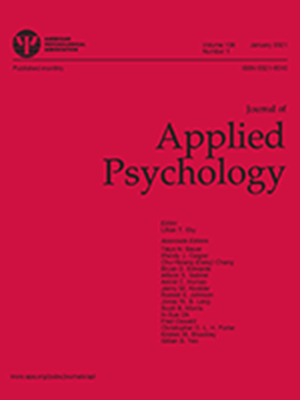Correction to "The dynamics of gender and alternatives in negotiation" by Dannals et al. (2021).
IF 6.1
1区 心理学
Q1 MANAGEMENT
引用次数: 0
Abstract
Reports an error in "The dynamics of gender and alternatives in negotiation" by Jennifer E. Dannals, Julian J. Zlatev, Nir Halevy and Margaret A. Neale (Journal of Applied Psychology, 2021[Nov], Vol 106[11], 1655-1672). In the article, "† p < .10" and "*** p < .001" were removed from the notes for Tables 3, 4, and 5. In Table 6, five values in the "Total dyads" column and three values in the "% Impasses" column were corrected in the male-female and male-male gender composition categories. In the first paragraph of the "Results and Discussion" section for Study 2, the B and SE values for differences in aspirations set by gender were corrected from B = -0.10, SE = 0.29, to B = -0.03, SE = 0.10. These corrections did not alter any of the article's conclusions. The online version of this article has been corrected. (The following abstract of the original article appeared in record 2021-03654-001.) A substantial body of prior research documents a gender gap in negotiation performance. Competing accounts suggest that the gap is due either to women's stereotype-congruent behavior in negotiations or to backlash enacted toward women for stereotype-incongruent behavior. In this article, we use a novel data set of over 2,500 individual negotiators to examine how negotiation performance varies as a function of gender and the strength of one's alternative to a negotiated agreement. We find that the gender gap in negotiation outcomes exists only when female negotiators have a strong outside option. Furthermore, our large data set allows us to examine an understudied performance outcome, rate of impasse. We find that negotiations in which at least one negotiator is a woman with a strong alternative disproportionately end in impasse, a performance outcome that leaves considerable potential value unallocated. In addition, we find that these gender differences in negotiation performance are not due to gender differences in aspirations, reservation values, or first offers. Overall, these findings are consistent with a backlash account, whereby counterparts are less likely to come to an agreement and therefore reach a potentially worse outcome when one party is a female negotiator empowered by a strong alternative. (PsycInfo Database Record (c) 2025 APA, all rights reserved).对Dannals等人(2021)的“谈判中的性别和替代方案的动态”的更正。
Jennifer E. Dannals, Julian J. Zlatev, Nir Halevy和Margaret A. Neale撰写的“谈判中的性别和选择的动态”报告中的错误(应用心理学杂志,2021[11],Vol 106 bbb, 1655-1672)。在本文中,“†p < .10”和“*** p < .001”从表3、4和5的注释中删除。在表6中,在男女和男女性别构成类别中,修正了“Total dyads”栏中的5个值和“% Impasses”栏中的3个值。在研究2的“结果和讨论”部分的第一段中,性别设定的愿望差异的B和SE值从B = -0.10, SE = 0.29修正为B = -0.03, SE = 0.10。这些更正没有改变文章的任何结论。本文的在线版本已被更正。(原文摘要见记录2021-03654-001)先前的大量研究证明了谈判绩效中的性别差异。相互竞争的说法表明,这种差距要么是由于女性在谈判中的刻板印象一致的行为,要么是由于刻板印象不一致的行为对女性产生的反弹。在这篇文章中,我们使用了一个超过2500名个体谈判者的新数据集来研究谈判绩效如何随着性别和一个人对谈判协议的替代方案的强度而变化。我们发现,只有当女性谈判者拥有强大的外部选择时,谈判结果中的性别差异才会存在。此外,我们的大数据集允许我们检查一个未被研究的绩效结果,僵局率。我们发现,在谈判中,如果至少有一名谈判者是一名拥有强大替代方案的女性,那么谈判多半会陷入僵局,这种绩效结果会导致相当大的潜在价值未被分配。此外,我们发现这些谈判绩效的性别差异不是由于性别在愿望、保留价值或首次报价方面的差异。总的来说,这些发现与反弹的说法是一致的,即当一方是女性谈判者时,对方不太可能达成协议,因此可能会达成更糟糕的结果。(PsycInfo Database Record (c) 2025 APA,版权所有)。
本文章由计算机程序翻译,如有差异,请以英文原文为准。
求助全文
约1分钟内获得全文
求助全文
来源期刊

Journal of Applied Psychology
Multiple-
CiteScore
17.60
自引率
6.10%
发文量
175
期刊介绍:
The Journal of Applied Psychology® focuses on publishing original investigations that contribute new knowledge and understanding to fields of applied psychology (excluding clinical and applied experimental or human factors, which are better suited for other APA journals). The journal primarily considers empirical and theoretical investigations that enhance understanding of cognitive, motivational, affective, and behavioral psychological phenomena in work and organizational settings. These phenomena can occur at individual, group, organizational, or cultural levels, and in various work settings such as business, education, training, health, service, government, or military institutions. The journal welcomes submissions from both public and private sector organizations, for-profit or nonprofit. It publishes several types of articles, including:
1.Rigorously conducted empirical investigations that expand conceptual understanding (original investigations or meta-analyses).
2.Theory development articles and integrative conceptual reviews that synthesize literature and generate new theories on psychological phenomena to stimulate novel research.
3.Rigorously conducted qualitative research on phenomena that are challenging to capture with quantitative methods or require inductive theory building.
 求助内容:
求助内容: 应助结果提醒方式:
应助结果提醒方式:


